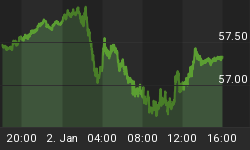Yesterday I posted a chart of COMEX October 1979 gold, showing the very nice run gold had back in '79. It went from just under $240 to just over $440, nearly doubling in the span of a year and selling off to around $370 when the contract expired. To some, it may have looked like a top, but the real fireworks in gold were still to come. Below is the chart of COMEX April 1980 gold, showing the metal's the metal's all-time high.
Most of us know that gold hit at all-time high of $850 in 1980, but we don't know how it got there. I dug up this chart from Jack Schwager's excellent book, Schwager on Futures. (Schwager is better known for his extremely excellent book Market Wizards - interviews of the greatest living traders).
Without further ado, the chart!


This chart puts today's "overextended" prices into perspective. February 2006 Gold is currently trading at around $524 in the electronic market as I write this (on the evening of 12/8/2005). Note on the chart above that it only took 15 trading days for gold to run from similar levels in 1979 to its all time intraday peak of over $900. The dots on the chart are "limit" days. A limit day is when there is so much demand on one side of the market that, due to exchange rules, the price is only allowed to move a specified amount, then no more trades can take place! That is great if you are long and it's limit up, but terrible if you are short and want to get out. Today the limit price on gold is $75, but it looks like it was about half that back them. If you know exactly what the limit was, or if you have any good stories from the time, please email me.
One reader who saw the chart I posted yesterday pointed out:
"One thing I've continually seen overlooked in the explanation for the rise of gold during 1979-80, especially the final parabolic spike, was the Soviet invasion of Afghanistan."
Quite true. It may seem like ancient history now, but only because we know how the story ends. At the time, the Soviet invasion of Afghanistan, which began around Christmas 1979, was a terrible global shock. The Soviets had just signed a "bilateral treaty of cooperation" with Afghanistan in 1978, but by the next year relations had deteriorated, and:
On December 27, 1979, 700 troops, including 54 KGB spetsnaz special forces troops dressed in Afghan uniforms seized all major governmental, military and media buildings in Kabul, including their primary target - the Tajbeg Presidential Palace, where they killed President Hafizullah Amin. [Before this was even completed,] the Soviets announced on Radio Kabul that Afghanistan had been liberated from Amin's rule. [From Wikipedia]
It was a slap in the face to a cold war America already weakened by high inflation and unemployment, a struggling economy, and high energy prices. The future of the American economy and American power did not feel at all certain. As a safe haven in times of panic and strife, gold simply reflected that fear. But notice how quickly the buying panic subsided and in fact turned into a selling panic after the emotion had been digested and rationality returned. The all-time peak was immediately followed by two consecutive limit-down days. When emotion subsided, it took the price of gold along with it. This marked the beginning of a 22 year bear market in gold.
Many of you may be trading gold today. With the benefit of hindsight, it is easy to see where to buy and sell. But if you were trading gold in '79-80, do you think that you would have been able to ride it to the top, without getting spooked out? Once at the top, would you have the courage to sell? Undoubtedly there were people at the time calling for much higher levels: "The economy is going to hell! Gold is going to $2,000 and beyond! You'd be a fool to sell." Times may change, but human nature does not.
This is not intended to be a prediction or indication of what will happen to the price of gold in the coming days or years, only an illustration of how difficult it is to forsee future conditions and a reminder that there is no such thing as a sure thing.
Please email me with your comments. What kind of fear is the price of gold reflecting today? Is it just inflation, or is it something more? If you have an interesting story about gold, or trading in general, I would love to hear it.
Subscribe to my low volume, email announcement list to be notified when new articles are posted.
Charts, links and financial news -- both the bull and the not bull -- updated daily on the homepage.
















